Civic Impact
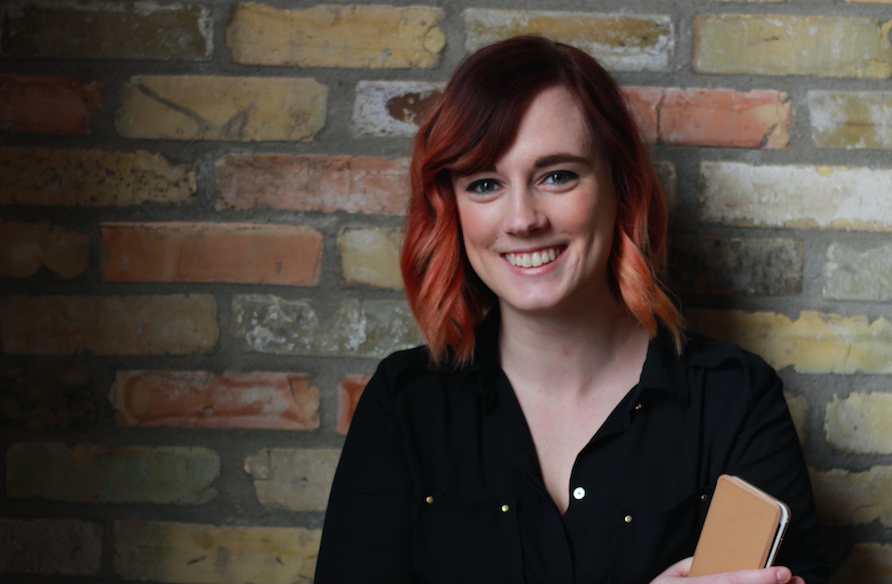
Ways We Work started because Amandah Wood was looking for a mentor. “I was working in my first job out of university two or three years ago. I was feeling really overwhelmed. How do people decide what tools to use? How do they break up their week to make sure they’re productive?” She came up with a list of ten questions and began sending them to people she found inspirational. “That turned into a blog,” she says.
Wood is the Founder and Editor of
Ways We Work, an online publication devoted to showcasing some of the best and brightest minds in the creative, digital, and design fields. “We focus on people who are really passionate about the work they do. Often, they’ve chosen the work they do over something else. We talk to them about the challenges of the work, the challenges of how they go there, and how they work.” In two years, the blog has grown from a simple Wordpress site to a thriving collection of profiles, features, and photography. Leaders from Mozilla, Pinterest and Buzzfeed, as well as freelance writers, editors, photographers, and filmmakers, offer insights into their career paths.
“I had this selfish motivation that I was going to send these questions to people and then I would have all the answers,” laughs Wood. “But everyone is figuring it out. No matter what point I talk to someone in their career, they still have challenges.” Wood sees the blog as a way to share the expertise that people are offering her. She cites the Vice President of Design at Buzzfeed, who said that no place is free of challenges. “But are the problems and challenges that I’m facing ones that I find valuable to solve? And do I feel empowered to solve them? And maybe his team would have gotten that advice, but now all our readers get that too.”
This summer, Ways We Work will expand to include a job board focusing on the Toronto, San Francisco, and New York regions. “We’re hoping to encourage people to write job postings in a Q&A style: what is this role, why is it interesting. We’re hoping for cultural fit rather than always a skills checklist.”
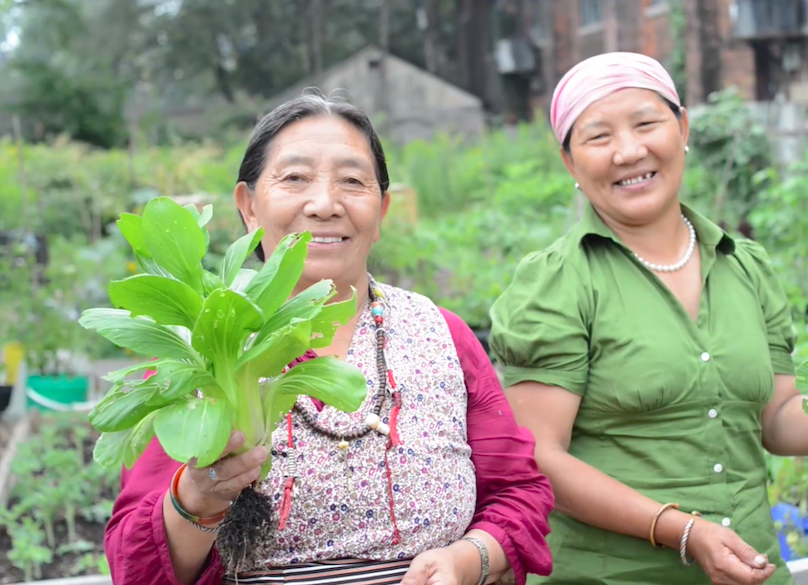
A patch of back-alley land has undergone a decade-long transformation from an underutilized privately-owned plot to a thriving community garden that produces over one thousand pounds of fresh vegetables each year. Now, The Milky Way Lane garden is looking at
new identity, as the first plot of community-owned land purchased by the Parkdale Neighbourhood Land Trust.
“The Milky Way garden is a pretty unusual community garden, because it’s on private land,” explains Joshua Barndt, Development Coordinator of the Parkdale Neighbourhood Land Trust. The plot’s owner, a local filmmaker, was unable to acquire the permits needed to build housing on the plot, and it went unused. About ten years ago, Tish Carnat, an ESL teacher at the Parkdale Library, had a conversation with her students about the costs of vegetables. The students, mostly refugees from India and Tibet, said produce available in stores was “quite unaffordable,” says Barndt. “But they had quite a bit of experience with growing food.” Carnat approached the owner of the plot, and a community garden was seeded.
For the past decade, the library’s ESL students have worked about 40% of the lot, growing vegetables in raised bed. “The class gardens every Monday morning from nine to noon” says Barndt. “Throughout the week, the students who are interested are going there on their own time and taking care of the site.”
“Parkdale has undergone a very rapid gentrification, and land uses like this have a huge benefit to the neighbourhood,” he says. The Parkdale Neighbourhood Land Trust has partnered with Greenest City; once the plot is purchased, Greenest City will develop programming for the space. “We’ve promised to keep a newcomer community garden on the site, but the rest of it will be used for what they called intensive growing,” says Banrdt.
The Parkdale Neighbourhood Land Trust sees this purchase as the first in a larger conversation about land uses in Parkdale. “In our society, there’s a premise that the land goes to the highest bidder, but we think we need to preserve land for community benefits,” Barndt says. They’re currently raising money to finance the purchase of the garden; in the future, the group may look at housing, storefronts, and other spaces as potential land-trust purchases. “We need to be proactive to ensure that we have the mechanisms in place to keep the neighbourhood affordable and diverse.”
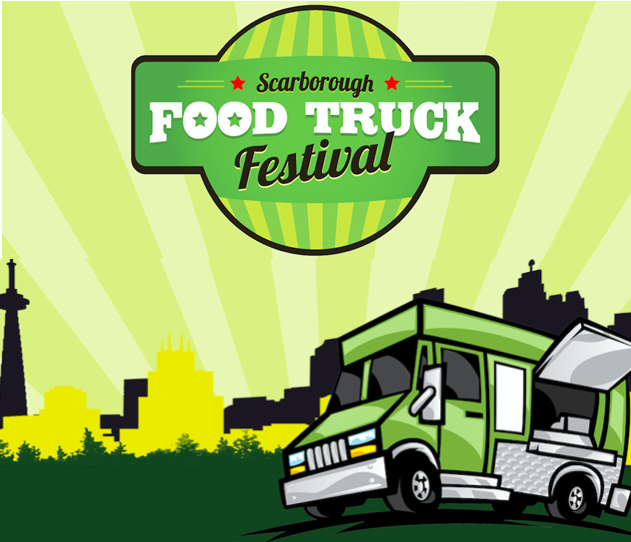
On May 28, some of the GTA’s best and most delicious food trucks with gather in Scarborough in support of the Boys and Girls Club of East Scarborough. “Foods trucks have been a great addition to our city, but you often have to travel downtown to experience them. We want to make sure the people of Scarborough could experience them the same way you can at some of the bigger festivals,” says Judene Stewart, Resource Development and Communications Coordinator for the Boys and Girls Club.
The day, which kicks off at 11 AM at the University of Toronto's Scarborough campus, convenes seven trucks offering tasty treats like lasagna, coffee, Caribbean food, award-winning poutine, and more. It also doubles as a community festival: there will be face painting, a chance to get hands-on with reptile from Reptilia, and demonstrations from capoeira and gymnastics troupe Kadara Capoeira. “At the Boys and Girls Club, we know how to put on a fun community event!” says Stewart. “There will be something there for everyone.”
The festival is in support of the Boys and Girls Club’s youth programming, which Stewart says “is the area that we struggle the most to fund.” The Club offers leadership development programs, sports, academic support, and young mens and young womens clubs for youth.
The day, which is the first of its kind for the Boys and Girls CLub, also represents partnerships with several prominent local organizations. “The University of Toronto Scarborough has been a supporter,” says Stewart, and adds that the Rotary Club, CIBC, Mellon, and Sharp Canada have also come onboard to sponsor the day. Food truck vendors will also be making donations to the club.
“We want people to come out and support our clubs. We serve six thousand children and youth each year,” says Stewart. “It’s to bring our community out, and to be able to enjoy a great day.”
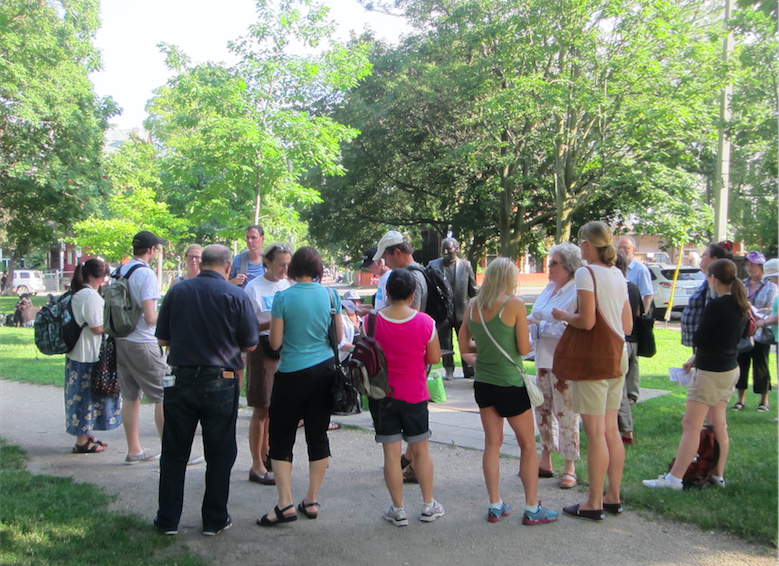
“The tour was a way of looking at Kensington Market that draws attention to the different layers that have made up this neighbourhood. We go right back to the end of the last ice age, and then work through the controversial Toronto purchase of 1787,” says Bruce Beaton. On Sunday, May 15, Beaton helped lead a crowd of roughly 70 people through Toronto’s historic market on a tour called “The Layers of Kensington Market.” Beaton, a Director at Large with the Kensington Market Historical Society, also shared details about the area’s history as a Victorian suburb and a Jewish marketplace. “And all those different layers are here still, if you know where to look for them,” he says.
Starting at statue of Al Waxman in Bellevue Square Park, the tour wound through the market, tracing about 25 stops along Oxford, Baldwin, Augusta, College, Spadina, and St. Andrew. “When we were doing the research, we joked that a densely layered walking tour of Kensington Market would require seven hours plus snacks,” laughs Beaton. “We pick and chose things that were visibly notable on the tour, and that had the most relevance to the experience of walking through the neighbourhood.” Landmarks like Grossman’s Tavern and the former site of Zimmerman’s Discount were highlighted, along with parks, synagogues and the shifting merchant nationalities of the area.
The tour was a partnership between the Kensington Market Historical Society and Heritage Toronto. “They asked us to do the tour. It was a great kick in the pants to get it going. They were very supportive and encouraging, and it was great partnership,” he says, adding that the tour can now be adapted to suit different groups, including middle-school students who study urban environments as part of their curriculum. The Kensington Market Historical Society also runs free events at the Lillian H. Smith branch of the Toronto Public Library; their next talk, on June 14, covers "Boxers, Bookies, and Bootleggers: the Underbelly of Early Jewish Toronto."
Toronto recently began a two-year study to decide if Kensington Market will be added to the city’s 21 heritage conservation districts. For Beaton, tours like this help people see the many examples of history that the market contains. “The market is interesting because it works by accident - it’s not a place that you could design. It works because of how it’s grown as an organic beast. It’s vibrant in its chaos.”
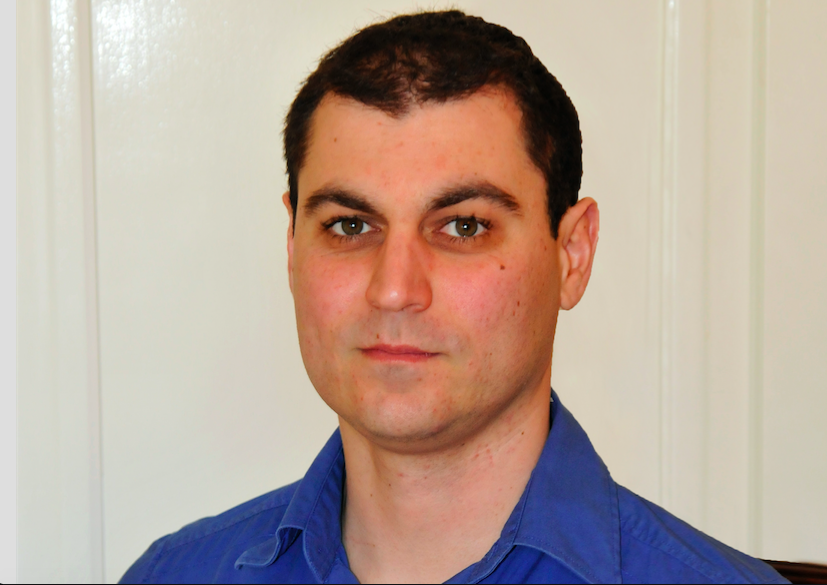
From May 9 to July 31, Frank Tsonis will bring his unique skills to the Toronto Public Library as its newest Innovator in Residence. Tsonis, an interactive media developer and educator who has taught at York University and OCAD, is skilled in both iOS and Android platforms commonly used in mobile phones. In addition to a trio of lectures touching on user interface and user experience that will discuss popular apps like Instagram, Tsonis will teach beginners how to develop their own apps.
“The courses that I’m teaching are an introduction to programming, and people who have no knowledge of programming can gain the skills,” says Tsonis. His next classes cover the language of programming, and will build from basic to more advance. “You can start to develop a basic Apple app and Android app, from start to finish.” The courses, which are free, run over several half-days.
Tsonis says becoming the library’s Innovator in Residence was a natural extension of both his eight years of teaching experience and his work as a new media artist working in interactive installations. “I’ve noticed the library has been changing their education program, and recognizes the importance of digital literacy,” he says. In the past, the library has hosted courses, lecture, and events about 3D printing, robotics, and design. “Mobile apps are so prevalent and everyone uses them on a daily basis,” says Tsonis.
He opens his courses by introducing students to Processing, a free, open-source coding program. “If you write four or five lines of code, you can automatically see its power. It’s a great tool to overcome the daunting feeling of learning to code.” In July, Tsonis will instruct teens in the basics of programming as well. After his residency ends in June, Tsonis will continue teaching, now with new experience outside university and college classrooms. “It opens my eyes to how people come to the table and grasp the information, and helps me understand how people learn these topics. I’m also excited to what kind of apps people generate in my classes!”

While numerous studies showing the health benefits of spending time in nature, it’s not always easy to carve out a daily ritual. For the fifth year, Genuine Health and the David Suzuki Foundation have partnered on the 30x30 Nature Challenge, which encourages Canadians to spend at least 30 minutes a day, for 30 days in May, in natural settings.
The benefits are huge, says Letelle Spezowka, Community Relations and Events Manager for Genuine Health. “It improves your work ethic, and helps people have fewer sick days—as a workplace challenge, it really makes sense,” she says. “There’s also a therapeutic effect: gardening, being nature, submerging yourself in it, gives you a sense of well-being and relaxation.”
Cultivating “the nature habit” in downtown Toronto isn’t always easy, and doing the challenge means Torontonians must seek out green spaces. “There are rooftop areas people don’t always know about, and the challenge gives them an opportunity to find those spaces,” says Spezowka. She suggests visiting parks like Trinity-Bellwoods or High Park as a way to get immersed in green spaces.
Spezowka also recommends less obvious places to commune with nature: “Go up the CN Tower and look at the view!” She says that finding nature in the city requires people to “think big, and think small. Have some plants in your home or condo, or making sure you have fresh-cut flowers at your workplace. Even looking at images of nature can be beneficial.”
Genuine Health is offering prize packs including camping gear, tea, and picnic supplies to help encourage Canadians to join the challenge. Participants are encouraged to write a love letter to nature, snap a picture, and post it on social media for a chance to win. But for most people, just being outside in Ontario’s natural spaces will be rewarding enough. Says Spezowka, “There are waterfalls, the escarpment, and so much out there. There’s a lot to explore.”
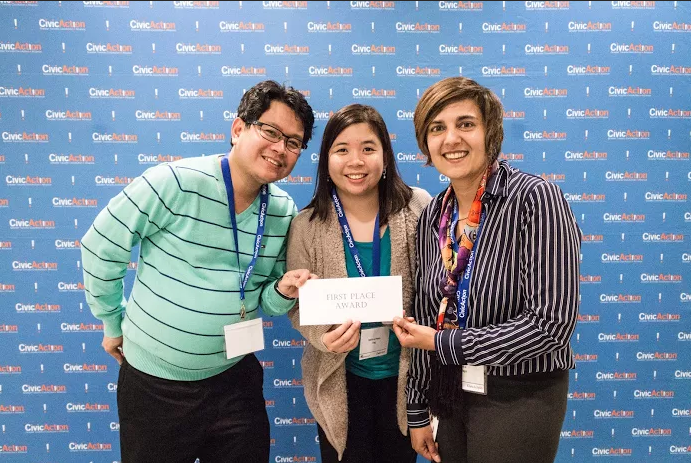
On May 5, five promising new start-ups had the opportunity to pitch their ideas in front of a panel of judges and a crowd of supporters. From two park-related apps, to an online platform aimed at educating newcomers to Canada about sexual health, to a pilot program trying to integrate flexible childcare with emerging career needs, to a program looking at indigenous history, The Emerging Leaders Network ELNshowcase showcased a variety of ideas that will help shape the future of Toronto.
The showcase winners were the Get Outside! Toronto Parks+Trails App. “We’re calling the all-access experience guide to finding anything and everything to do with Toronto parks and trails,” says Neluka Leanage, the project’s overseer. “A lot of people think they have to go out of the city for nature experience, so we’re trying to showcase what’s here on offer and what won’t cost you a car trip out of the city.”
Get Outside! combines user-input information with open-source like Google Maps to allow a fuller and more developed parks and trails experience than the City of Toronto currently offers. “The city is missing a bunch of data around parks: they don’t have all the locations of water fountains, or whatever the latest maintenance issues are,” explains Leanage. “What we’re trying to do is engage people who regularly snap photos anyway. We want people to be able to tell the city something about their park in a different way.”
The team behind the app hopes to partner with city staff in order to roll out the app. Leanage says that the app may eventually help supplement or replace public consultations about parks. Until then, the app will supplement users experiences by giving them a chance to upload their own tips and photos, and see what others have input as well.
Leanage says participating in the showcase was “little intense,” but the judging sessions and networking opportunities gave the Get Outside! team the boost they needed to win. Over the next year, they will use their winnings, which include a hot desk at the Centre for Social Innovation and start-up funding, to help flesh out their app. They anticipate that, by next spring, Get Outside! will be encouraging Torontonians to do just that.
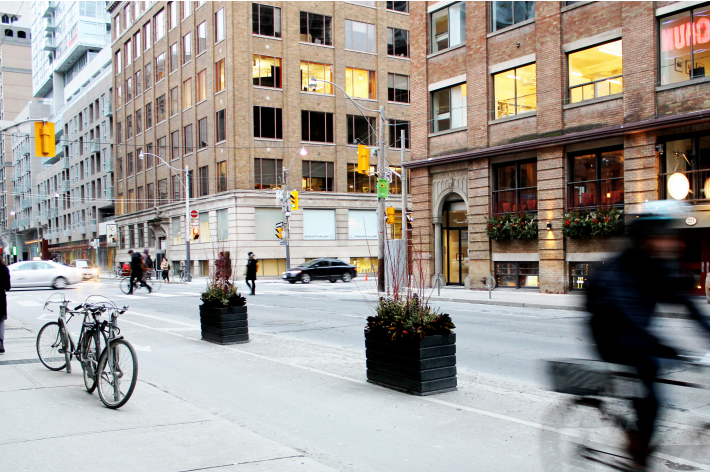
The Toronto Centre for Active Transportation has long been a cheerleader for Complete Streets policies; now, they’ve put their success stories down on paper. “The philosophy is that we should be building streets that are everyone to use, no matter how they get around,” says TCAT Director Nancy Smith Lea. Along with professors from the University of Toronto and Ryerson University, Lea is one of the lead authors of “Complete Street Transformations in the Greater Golden Horseshoe Region,” which profiles nine local streetscapes that prioritize pedestrians, cyclists, and people using public transportation.
“It’s a shift from how we’ve been doing things for the past many decades, when we’ve been mostly been facilitating motor vehicle traffic. It’s looking at things from a different perspective,” says Lea. The new book evolved out of a recent catalog, published by TCAT, which examined Complete Streets projects already under development in the Greater Golden Horseshoe region. The catalog’s goal was to measure the streets’ successes. “There just isn’t enough information out there about how the streets are being evaluated and how they work in different contexts,” explains Lea. “We wanted to compile as much information as we could about how effective those designs were, and put them side-by-side so people could look at them.”
Complete Streets Transformations examined nine different completed projects, in a variety of contexts, including rural, urban, and suburban. “We wanted as diverse number of projects as possible,” says Lea. The Complete Streets philosophy is becoming more widespread in the US, where over 700 local policies have been implemented. “In Canada, it’s a bit of a different situation,” says Lea. She points to St. George Street in downtown Toronto as a local example of how the philosophy’s influence. “Built in the late 90s, nobody called it a complete street then, but they call it one now.”
Lea hopes the book will be used by regional planners and municipal staff as an advocacy tool, as well as a tool to help evaluate the impact of the design of these streets. “It’s the minority of streets that we build in this way. Most streets are build in the old way,” she says. “These projects are a good thing, especially in terms of increasing safety for cyclists and pedestrians.”
On May 10, Mississauga got a new reason to be green: the Tree and Wood Recovery Centre, a joint project between the Toronto Region Conservation Authority and Sawmill Sid, opened their doors. "The main thing we want to accomplish is to respect the wood," said Sheila Storey, the CEO of Sawmill Sid. "The wood that we’re using at the diversion lots doesn’t need to be wood chipped."
Instead, the Tree and Wood Recovery Centre will process usable wood from felled trees (like those affected by the
Emerald Ash Borer) into lumber, live edge wood, and pieces that are suitable for projects. Storey says that one family recently brought in their trees to be transformed into a variety of pieces, including a dining room table and a guitar. "if people want to create a legacy, they can purchase repurposed wood, and come into the shop and work on it together as a family," says Storey.
Keeping the trees out of the wood chipper will also have a positive environmental impact. "If the wood is kept in lumber, tables, siding, we’re talking tonnes for carbon every year that could be captured." She's especially interested in working with developers across the GTA: as trees come down for new buildings, they leave a lasting hole in the neighbourhood. "If people know the trees are coming here and can be utilized, that really helps with that problem," she says. Recently, she worked with a senior centre developer whose felled trees will return to the centre as lumber. Additionally, Storey says that up to 20% of the Tree and Wood Recovery Centre's profits will be donated back to the TRCA.
The launch of the Tree and Wood Recovery Centre included milling demonstrations, snacks served on charcuterie boards produceds from trees milled by Sawmill Sid, and chainsaw sculptures.
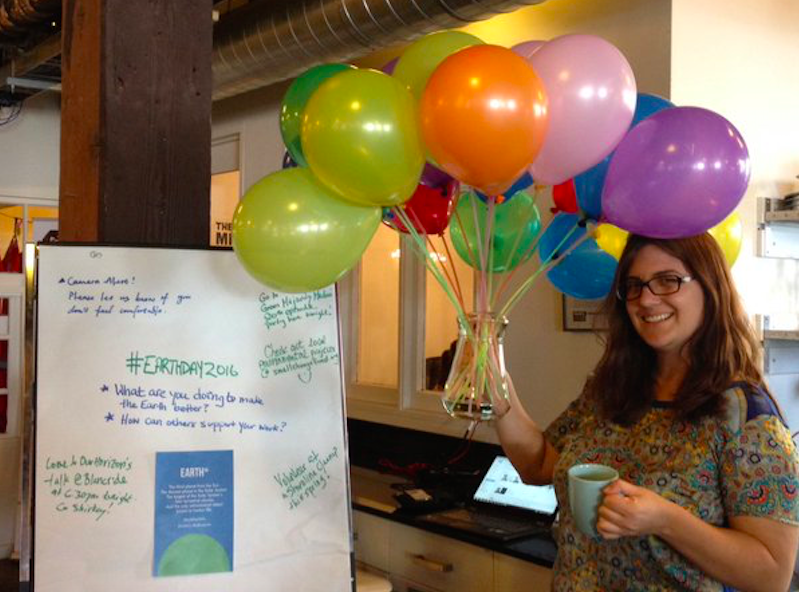
Wednesday, April 27, 2016
“The average cup of coffee takes 46 litres to make,” explains Victoria Alleyne, “It’s so much, but no one thinks about it. Once people know, they can start to make it a difference.” Alleyne is the founder of Full Footprint, an organization devoted to measuring the ecological, carbon and water footprints of common goods and services, like coffee.
For Earth Day, Alleyne partnered with the Centre for Social Innovation Cafe to educate members of the CSI community and the general public. The Centre for Social Innovation Cafe uses coffee from Merchants of Green, which offers a lower-impact product to coffee shops across the GTA. Coffee drinkers were offered a 3.5 centimeter-square piece of paper, representing the area of land that is saved on each cup of coffee by using ecological methods. Full Footprint also offered information about carbon, ecological, and water offsets as part of the day’s educational component.
Members of the CSI community got involved as well. Small Change Fund, Green Majority Media, and Our Horizons were all present at the event. “CSI members came out and gave some advice and guidance on how to make change,” Alleyne says.
For Alleyne, the 260 cups of coffee consumed that day represent more than just a caffeine kick. “Using coffee from a more environmentally friendly vendor resulted in preventing 20kg of carbon from entering into the atmosphere, saved 1 metre squared of land from having its trees and other plant life cut down, and saved 130 litres of water along the life cycle of the coffee,” she says. Full Footprint plans to purchase offsets to take care of the rest of the day’s environmental impact.
As for Alleyne, she’s more of a tea drinker. But, she says, “A lot of people in co-working spaces identify that coffee fuels their change. It’s an easy way to communicate the message.”

Wednesday, April 27, 2016
“This isn’t a niche group of people, this is the fastest growing source of employment in the country, and probably in most of the developed economies of the world.” Andrew Cash, founding member of the Urban Worker Project, is talking about the GTA’s freelance and contract workers. Cash, a longtime freelancer himself and a Member of Parliament for Davenport riding from 2011 to 2015, is part of a new coalition devoted promoting the workplace rights of workers not covered under Canada’s current employment standards.
“Allowing for parental support, employment insurance between gigs, support when contract workers get sick or need to take care of a sick relative. These are the issues that the project will be advocating around,” explains Cash. “This is the reality for young workers.” The Urban Worker Project’s first order of business is a petition asking the government to broaden employment standards to include self-employed, contract, and freelance workers—groups that are currently unable to access benefits routinely offered to permanent employees, such as vacation time or extended benefits. “If someone on contract is doing the same work as someone as an employee, they need to be receiving those kinds of benefits and protections. Our first campaign is calling on the provincial government to tighten to those rules.”
Cash is a part of a larger coalition that includes a number of GTA activists, students, media workers, and non-profit workers. “For us in the GTA, this is the epicentre of the arts and culture, and for the knowledge economy in general. The workers in these sectors are largely freelance, contract, or self-employed. I’d like to build a stronger floor for these workers,” says Cash. He encourages those who are interested in learning more to visit their website, where they can sign a petition to the Ontario government to strengthen protections for urban workers. The project officially launches May 6 with a party at Propeller Coffee in Toronto, before rolling out to Vancouver, Montreal, and other cities.
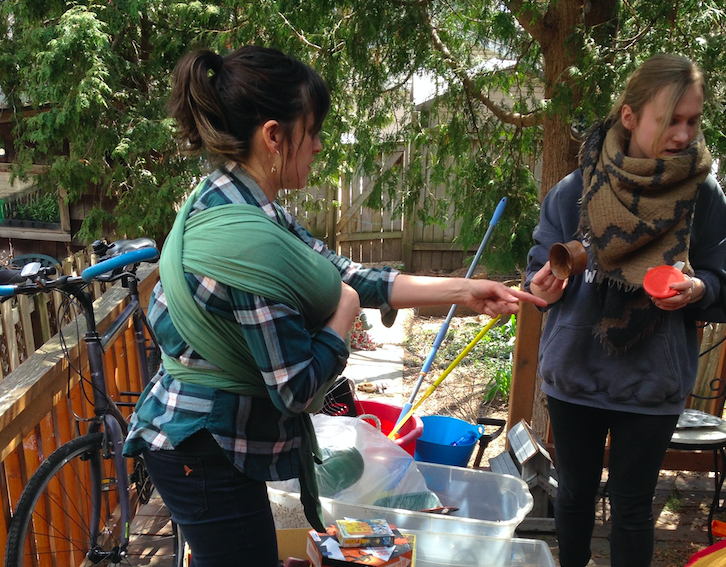
Wednesday, April 27, 2016
Curb alerts, reusable goods, trash treasures, curb scores: whatever you call them, it’s not unusual to find unwanted but perfectly usable goods dotting Toronto’s sidewalks on any given day. For Caroline Brooks, these items sparked the beginning of Second Hand Sunday, the second of which was held this past Sunday in Ward 21.
“It came originally from us looking at how much stuff we own. One of the things we’ve been looking at in our lives is how to limit how much stuff we buy.” Brooks, a member of the Second Hand Sunday organizing committee, says that one of the major drivers of this concern was the birth of her children. “You have a lot of stuff when we had a kid, so we were looking at ways to share those things.”
Second Hand Sunday is simple: on the last Sunday of April and September, households in Ward 21 (St. Paul’s) are encouraged to leave clothes, kitchenwares, electronics, books, furniture and other items that they no longer needs on the curb. Neighbours can then browse the streets, picking up goods that they might otherwise need to purchase. “We saw this as a way to promote the sharing economy. This was a way to share things rather than having them end up in landfills,” says Brooks.
The event started last September with thirty households participating. This weekend saw more than 150 houses across 45 streets placing their items up for grabs. “We wanted to make it as easy as possible,” says Brooks. “It was so nice to see people out in the neighbourhood, and it was a community event.” Local charities like Na-Me-Res, the YWCA, and Wychwood Open Doors also received donations from households in the ward, which Second Hand Sunday helped facilitate.
Brooks hopes that future Second Hand Sunday events spread into new wards. “Hopefully, it keeps growing,” she says. The next Second Hand Sunday will take place on September 25.
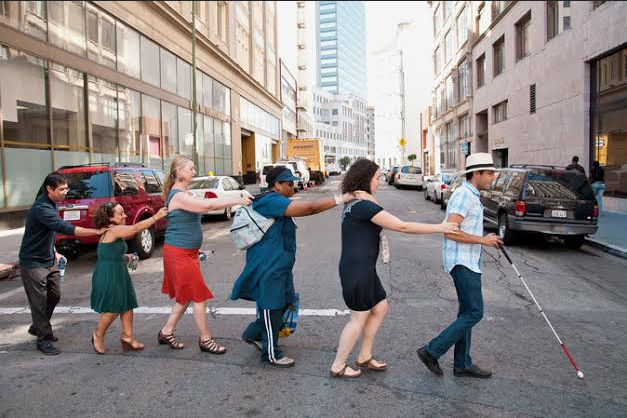
Wednesday, April 20, 2016
“Disability arts has a forty-five year history in Canada but currently there is a groundswell of interest in disability arts. It seems that everyone wants to program disability arts right now,” says Eliza Chandler, Artistic Director of Tangled Art + Disability and the programmer of Cripping the Arts, next weekend’s symposium devoted to the topic of disability and the arts in Canada. “We wanted to create an opportunity for cultural producers, both inside and outside of disability arts, to come together and discuss how to curate in an accessible way, the current aesthetic trends in disability arts, and how disability arts is connected to social justice.”
The inaugural symposium, which will be held at Ryerson University, sold out in twelve hours. Free to Deaf and disabled attendees, the two-day event aims to explore the related topics of accessibility and aesthetics in communities that produce and consume Deaf and disabled arts. The symposium will open with a keynote address by Ruth Gould, founding artistic director of the disability arts festival DaDaFest. “In the UK, there are federal government funding structures in place that support disability artists, and this support has led to a more developed disability arts culture,” says Chandler. During the day, topics of discussion will include different regional aesthetics in Deaf and disabled arts communities, issues of curatorial interest, and ensuring accessibility across the arts.
One of Chandler’s goals for the symposium is the development of a toolkit for Canadian arts producers. Tangled Arts will collect ideas generated over the weekend and make them available on their website as “guidelines for how to program disability arts and produce accessible events.” The ultimate goal is to bring disability arts into the limelight. “We hope that cultural producers have increased exposure to the disability arts talent in Toronto and across Canada, and are better equipped to program accessible events,” she says.
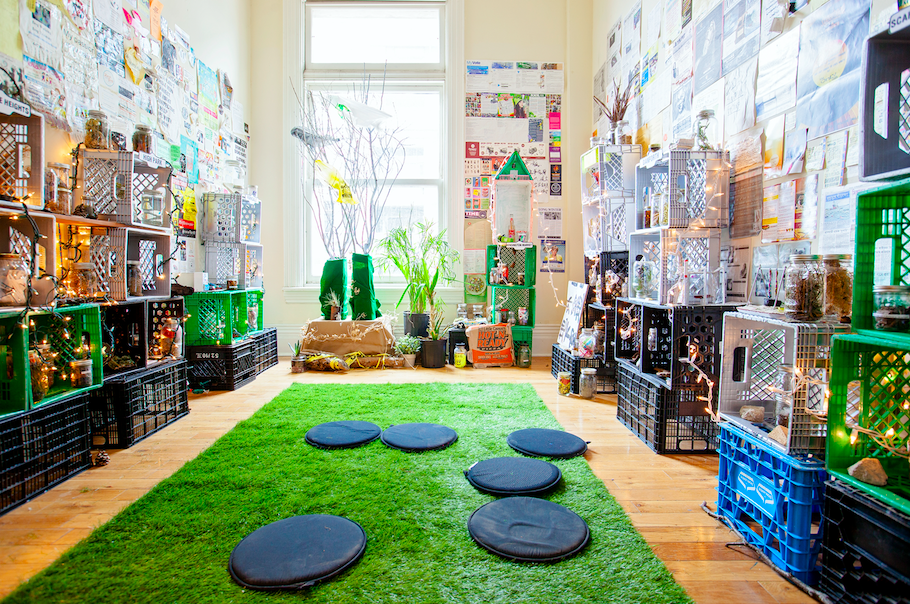
Wednesday, April 20, 2016
“We’re thinking about new ways to think about how humans live in the world,” says Graham Teeple. He’s one of the curators of this weekend’s Gladstone Grow Op 2016, a weekend-long festival hosted by the Queen Street West hotel.
Billed as “an exhibition on urbanism, landscape, and contemporary art,” the event kicks off on April 20 with Grow Op Talks, a panel discussion featuring local designers, professors, and other creative types. The festival continues through the weekend with an evening market dedicated to the future of food—including crickets, which Teeple says is “a new way of consuming protein.”
But if bugs aren’t your thing, Grow Op offers much more. More than thirty artists, thinkers, designers, farmers, historians, and activists will be exhibiting works devoted to how the world’s relationship to food, abundances, scarcity and natural systems co-exist (or don’t) with humans. Teeple says he’s especially excited about a collaboration with the Toronto Flower Market in which hundreds of flower bulbs will appear in the hotel lobby.
Grow Op, now in its fourth year, is devoted to exploring new ways of being ecological. “This year what we’ve really noticed is an even more diverse of artists applying to the show,” says Teeple. “I noticed more diverse groups: scientists, artists, storytellers, designers. Students and established artists, people who are working in social projects who have been doing these things for a number of years on their own, and now that have a context for this range of work.”
Grow Op also dovetails nicely with Earth Day on April 20. “As soon as we found out that Earth Day was happening around the same time, we decided to hold the opening on that day,” says Teeple. He sees the weekend as a “conversation starter” for Toronto’s designed and ecological communities. “I’m hoping that people walk away from the show with a whole bunch of new ideas, and a connection to this group of people who are focusing their work on those ideas.”
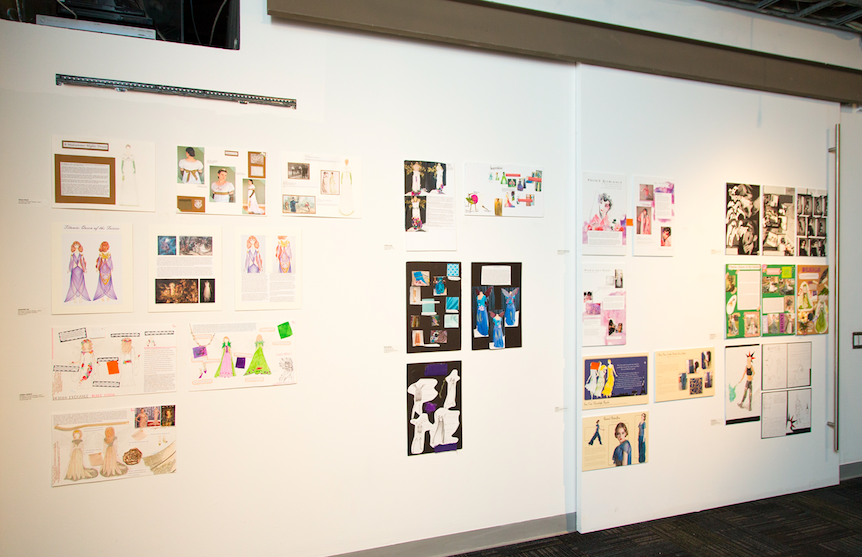
Wednesday, April 20, 2016
With nearly 800 entries every year, the Sears DX Canadian High School Design Competition represents the future of design in Ontario.
Students across the province can enter their work in five categories—fashion design, architecture or interiour design, industrial design, costume design, and graphic design—and under the guidance of an art or design teacher, or as their own independent submission. “Teachers have said how much they value this competition,” says Huard. “They see a real focus and commitment from the students, and they’re producing really high-quality work.” Winning students receive up to five hundred dollars in prize money, as well as the opportunity to show their work at the Design Exchange and receive mentorship from an emerging Canadian designer.
Students answer a design challenge in each category. This year, industrial designers were asked to create their own food truck, while fashion designers will be working on garments that can withstand all four seasons and still be fashionable. The costume design students’ challenge is Macbeth, and is presented in partnership with the Sears Drama Festival, the popular province-wide drama competition for high school students. “We’re three years in the partnership, and we see some great stuff coming out of that,” says Huard.
The Sears DX Competition is one of the few arts contests focused exclusively on design, and winners at the high school level often go on to continued success. “We try to assist young designers with opportunities at every stage of development,” says Huard. Past winners at the high school level have excelled at university- and emerging-artist competitions as well. Some of the credit goes to the mentorship program that is part of the prize, which connects winners with Canadian designers and professionals at Sears Canada.
Entries can be sent to the Design Exchange before the competition closes May 30. “It gives students a real insight into what’s expected in design, but it’s not scary,” says Huard. “The challenges are fun and creative and they’re meant to be inclusive.”